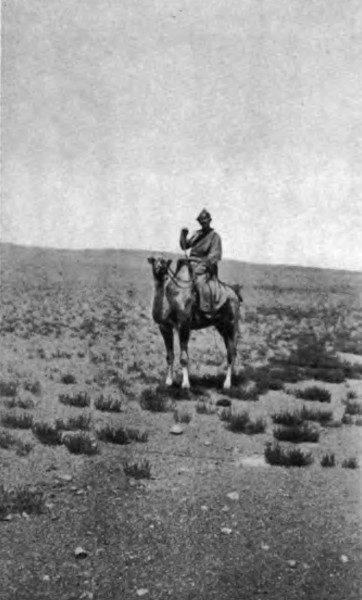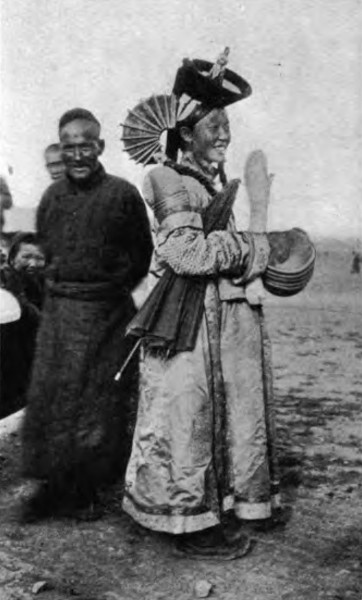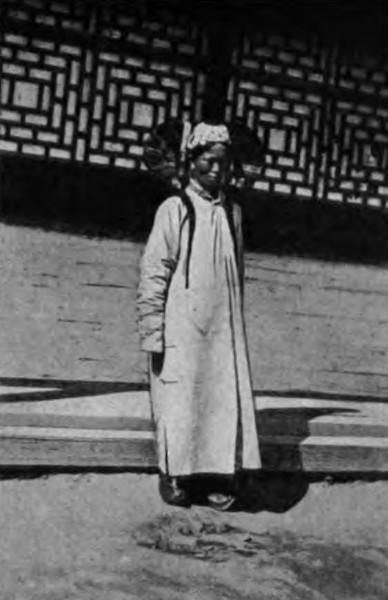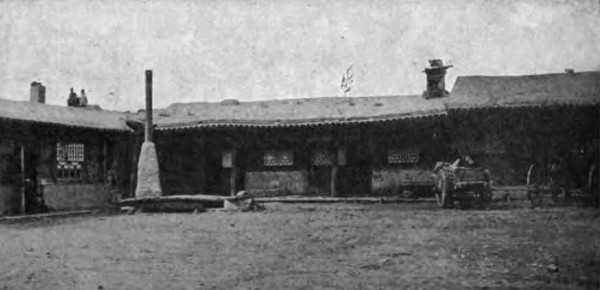| Web
and Book design,
Copyright, Kellscraft Studio 1999-2015 (Return to Web Text-ures) |
 (HOME)
|
|
CHAPTER XIV URGA, THE SACRED CITY Urga the
Sacred City, the home of the Gigin, the Living God,
third in the Buddhist hierarchy, is not so much one city as three, all located
on a high ridge above the Tola. Each is distinct, separate, entrenched.
Arriving from the south, the one you reach first is Mai-ma-chin, the Chinese
trading settlement, a tangle of small houses and narrow lanes hemmed in by
stockades of wooden slabs and unbarked fir trees. Here are the eight or ten
thousand Chinese who control the trade of North Mongolia. Apparently they make
a good living, for there is a prosperous bustle about the place, and as you pick
your way over the mud and filth of the streets, through open doorways you catch
glimpses of courts gay with flowers and gaudily decorated houses such as the
well-to-do Chinese build. But for the most part dull blank walls shut you out
or in. The Chinese is an unwelcomed alien in Mongolia, and he knows it. A strip of waste, treeless land, bare of everything
save a group of "chortens," that look like small pagodas, and a few
yurts and sheds, separates Mai-ma-chin from the Russian settlement which
occupies the highest part of the ridge, dominating
everything in a significant way. It centres in the consulate, a large white
building surrounded by high walls, but more prominent is the tall red
Russo-Asiatic Bank close by. Other buildings are a church and a few houses and
shops. The Russian Consulate also is well fortified, with the last contrivances
for defence, walls, ditches, wire entanglements, and it looks fit to stand
a siege. Before reaching Urga proper, the Mongol or lama city,
which lies about three miles farther west, shut off from the others by a branch
of the Tola, you pass the headquarters of the Chinese governor, and he, too,
has entrenched himself behind strong earthworks. Ta Huren, the "Great
Encampment," as the Mongols call Urga, which is not a Mongol word at all,
but merely a modification of the Russian "urgo," a camp or palace, is
a network of palisaded lanes enclosing, not comfortable houses and offices and
banks, as in Mai-ma-chin, but temples and lamasseries. And well within these is
the most sacred spot of all, the lamassery where dwells enthroned Bogdo or the
Gigin, the Living Buddha ranking after the Dalai Lama and the Tashi Lama only. To Bogdo the Mongol millions look up as a god; he is
the living representative of the divine one; and the city where he lives is the
goal of thousands of pilgrims each year. And what do they see? until late years, just a feeble, untaught child. When the Bogdo
dies, his soul is reincarnated in the body of a newly born male child. For a
hundred years or more that child has been always Tibetan, not Mongolian;
probably the Chinese Government knows why. And the lamas who swarm the sacred
encampment, debased representatives of a debased religion, probably could tell,
if they would, why, in the past, the child has never lived to be a man.
Furthermore, the Russian Consul-General at Urga probably knows the secret of
the long life of the present incumbent, who is well past the time that has
proved so fatal to his predecessors. Politics sordid and gruesome are active within the
gaily decorated walls of the sacred lamassery. But all that the outsider sees
is a weak, debased-looking man whose vices should soon end his days even if he
escapes the lamas' villainy. Formerly he amused himself with Western toys,
photography, and especially motor-cars. It is true the millions of Mongols look
to the Gigin as their divine leader, but after all there are ranks even in
divinityship, and when the Dalai Lama, fleeing from Lhasa before the
Younghusband expedition in 1904, took refuge here, they promptly forgot the
smaller god to worship at the shrine of a first-rate one, and the Gigin's nose
was put out of joint, and stayed so until his distinguished guest had departed.
It was to appease his wounded vanity that a Russian official presented him with
a motor-car which had been brought to Urga at vast expenditure of effort and
money. When I asked what he could have been expected to do with it, for roads
there were none, the answer was that to the divine one with fifteen thousand
lamas to do his bidding, anything was possible. A road was, indeed, constructed
to the Bogdo's summer retreat, a few miles away, but alas! no chauffeur was
supplied with the motor-car, and it would not run of itself. When I passed
through Urga last year I was told that the undaunted Bogdo had ordered a second
car, fully equipped with chauffeur and all, from America, which was even then
at Tientsin, so by now he may be getting stuck in the muddy lanes of the Sacred
City, unless he has put away such childish things to take up the farce of
governing Mongolia under Russian guidance.  A LAMA BOUND FOR URGA  A MONGOL BELLE, URGA For more than three hundred
years Lamaism has held Mongolia in its grip,
checking the development of the country, sapping the vitality and self-respect
of the people. More even than every other man you meet is a lama, for it is
estimated, by those who know the situation best, that five eighths of the men
are lamas, red or yellow, and the evil is on the increase. At least, two
generations ago Abbé Huc placed the proportion at one in three. But lamas are
not all of one sort. There are those who live in community, permanently
attached to some one of the hundreds of lamasseries.
They represent probably the abler or more ambitious in the priesthood, and are
better versed and more regular in the observances of their order, living a life
perhaps not unlike that in Western monasteries in their period of decline. It
is this class that rules Mongolia under Russia. Still another group might be
compared to the begging friars when their brief, glorious day was past; they
wander about the country, east, west, south, to Lhasa, to Omei Shan, to Peking,
with little purpose or plan. As Huc says, "vagabondizing about like birds
of passage," finding everywhere food and a tent corner, if not a welcome.
They neither teach nor heal, and represent the most worthless though perhaps
not the most vicious among the lamas. A third class, and the largest, has no parallel, I
think, in any Western church at any period. These are the lamas who, sent like
the others to the lamasseries at an early age, after having received the
prescribed training, taking their "degrees," as Huc calls it,
return to their homes to live the life of the ordinary Mongol, in no wise to be
distinguished from the "black man" save by their shorn heads and the
red and yellow dress, which they do not always wear. They marry after a
fashion, at least they take wives, though without even the ordinary scanty
formalities, and probably the tie is as enduring as the "black man's" marriage. In Southwest Mongolia I was told a
lama marries just like other people, while in some northern districts he has no
right to his wife, and if a "black man" takes her away he has no
redress. The Mongol who attended me on the first stages from Kalgan was a lama
with wife, children, and home, faithful and hard-working, at least for a
Mongol, and a useful member of society. The question one naturally asks is, Why do these men
become lamas; do they do it willingly or under compulsion? Apparently the
matter is decided for them by their parents, who send them when boys to some
lamassery where they are duly and meagrely trained; but they do not seem to
chafe at their condition when they grow up, for the advantages are very real.
The parents save in not having to buy wives for their sons, while the lama
himself is always sure of support if he goes back to his lamassery, and he is
free from all demands by the Government for military service. It is said that the Chinese Government has encouraged
Lamaism with the idea of keeping down the population; in this way it would
avert the danger of Mongol invasion. But Lamaism has already done that in
another way, by killing the vigour and warlike temper of the people. The memory
of Genghis Khan still lives in the land where he was born; tradition holds that
the Great Conqueror lies buried on the summit of
Bogda Ola, the mountain that towers over Urga, and no one may climb the height
lest his sleeping be disturbed. But it is the vicious weakling who holds
uncertain sway in the Sacred City, not the spirit of the mighty warrior, that
dominates the Mongol of to-day. Buddhism takes on many forms. On one side you have
the gentle, intelligent monk of Burma, and the kindly superstitious bonze of
China. But that black travesty of Buddhism, Lamaism, seems to offer no
redeeming feature; brutish in Ladakh, vicious and cruel in Tibet, it is
debasing and weakening in its effects upon the Mongol, who comes of finer and
stronger stock than either Ladakhi or Tibetan. But he sometimes succeeds in
being a good fellow in spite of his religion. The first day of my stay in Urga I devoted to
repairing the damages of the journey across the desert. Oh, the luxury of
plenty of hot water, of leisure, of privacy. I scrubbed and I mended, but above
all I rested. And if I tired of that, there was always plenty to see just
outside my door. The house where I was so kindly entertained was the home of a
rich Mongol trader, a man of many deeds and few words. It was built around a
large courtyard enclosed in a strong stockade some twelve feet high, the
buildings forming part of the enclosing wall. On the long side of the court was
a roofed-over space where carts and horses and fuel
were kept. To the right hand and to the left were kitchen, godowns, servants'
quarters, while on the side facing the great entrance gates boldly decorated
with the swastika symbol were the family and guest rooms. Along this front was
a narrow verandah roofed by the overhanging eaves of the one-story buildings.
Most of the windows were of the ordinary Chinese style, wooden lattices
covered with paper, but a few were glazed. My room was about fourteen feet by
ten in size, one half or more of the space being taken up by a platform some
three feet high, on which were a large gaudy rug and two or three tiny tables and
chests of drawers. The rest of the furnishing was a rough bench and two
decorated cabinets. The ceiling of the room was covered with a gaily flowered
European paper, and on the walls hung some cheap Chinese kakemonos. The state rooms, which were next to mine, were
evidently held in great esteem, and my hostess displayed them with the reverent
pride of a good New England woman showing her parlour. There were three of
them, opening one into the other. In each there was the invariable platform
covered by rugs, and big Chinese vases stood about on small tables. The life that went on in the courtyard was simple and
rather patriarchal. Servants, children, horses, everything was under the eye of
the master, a good-looking, dignified man. I found it rather difficult to distinguish servants and family; everybody seemed to be
on a familiar footing. But the joy of the place was a small boy, the son and
heir, who played with Jack or sat in my room inspecting my things by the
half-hour. According to Western ideas children in the East are not
"brought up," and it is true they are abominably spoiled, but at
least one's heart is not often wrung by seeing them slapped and beaten. One of my first rides abroad was to the Russo-Asiatic
Bank where I met much courtesy and helpfulness. Thanks to the bank officials in
Peking I was expected, and I found a warm welcome, and a house ready prepared
for me, which, however, I could not use, as I was already settled where I was.
There is a community of about five hundred Russians in Urga, mostly traders and
officials, and a fifth as many soldiers protecting them. The look of the
Russian quarter takes you across the sea, for many of the houses are of logs
set in a grass yard, the whole surrounded by a high board fence, almost a
stockade in strength. Far East and Far West have met, and the homes of the
Russian pioneer and American frontiersman are much alike. For many decades Russia has been extending her
influence into North Mongolia, patiently and persistently, and now through
trade and employment she has the country in her grasp. Almost the only foreign
people the Mongol knows are the Russians, and as a rule he seems to get on with
them rather well, although a Russian official told me he doubted if there was
much to choose between the Chinese and the Russian traders; both fleeced the
poor nomad. However, European onlookers, who know Mongolia well, declare that
if it came to war between China and Russia, the Mongols would take sides, and
with the Russians.  MY MONGOL HOSTESS  THE MONGOL HOUSE WHERE I STAYED IN URGA When I was in Urga there was much talk among the Chinese about the railway that was surely coming, and
the Kalgan officials said the same thing. One only wonders that it was not done
half a dozen years ago; there are no serious difficulties. Once outside the
Great Wall, the rails could be laid down on the top of the ground almost as
fast as a man could walk. Only as you approach Urga, north of the desert, would
there be much in the way of bridging and embanking. And it would soon pay for
itself, for the millions of taels' worth of trade done between North Mongolia
and China would easily be doubled if once freed from the handicap of the costly
and uncertain journey of to-day. But more important than all else is the
political side of the question. The Chinese Government must have known for
years that its hold on North Mongolia was insecure; it has pushed forward
colonization by the Chinese with much more than its usual vigour, and, given
time, that would have settled the matter. But it had no right to count on having time, while a railway across the desert, taking
not long to build, would have bound all Mongolia to the empire with bands truly
of steel, that even the Russians could not break. And now is it too late? The hours were quite too short which I had to spend
in Urga, the Urga of the Mongols; the other settlements were merely frontier
posts, one Chinese style and the other Russian, new and uninteresting. But
Urga, Ta Huren, was another story. To reach it we forded the river, the strong
current washing my feet as we rode through. There may be some other way, but
that sort of thing is part of the ordinary day's work with the Mongol, and I
believe he is rather shy of the one or two bridges the Russians have built. Ta Huren has a temporary look that suits its name;
fire or flood could easily sweep it away. And there is nothing of any
architectural interest save two or three temples and lamasseries, and having
seen one you have seen all, for there is little of beauty or fine workmanship
about them. The broad main street and the open spaces above the river were much
more attractive, for there the life of the settlement had gathered, and again
you had the impression of a holiday. There was too much leisure, too much
jollity, and too much colour for the work-a-day crowd of
the West or of China. People came and went, stopped to talk, stopped to stare.
No one seemed in a hurry except one or two self-important officials and their
white-jacketed retinue. Only in the horse-market was there any real business
going on. There the crowd seemed really intent on something, but buying and
selling horses is a serious matter the world over, in Kentucky or in Mongolia.
Indeed, the whole scene reminded me of nothing so much as "Court Day"
in Kentucky, done in colour. But the colour made all the difference. Everywhere
there were lamas, of course, lamas in red dress and red hats, or lamas with
blue-black shaven heads set off by yellow or flame-coloured garments. Women
came and went on foot or on horseback, alone or in groups, just as much at home
in the motley crowd as the men. Some of them were gorgeously attired, and the
flashing of their silver headgear was quite dazzling. Now and then I caught
sight of one more soberly clad and with a shaven head, a widow, perhaps, or an
old woman who had become the family priest to the extent of performing the
daily simple observances. Mingling with the gay, happy-go-lucky throng of
Mongols were two alien elements: one, the quiet, purposeful, observant,
blue-gowned Chinese, each intent on his business; the other, the blue-eyed
Cossacks in white caps and the big, bearded, belted Mujiks,
looking tremendously substantial as they lounged heavily along, lazily watching
the shifting crowd. I thought of the Afghan Amir Abdur Rahman's comparison of
Russia to an elephant, "who examines a spot thoroughly before he places
his foot down upon it, and, when once he puts his weight there, there is no
going back and no taking another step in a hurry until he has put his whole
weight on the first foot and smashed everything that lies under it." But
the Chinese are like the tide, coming in noiselessly, gently, filling each hole
and crevice, rising unnoticed higher and higher until it covers the land. Will
it sweep away the elephant? |